From the moment that the starting gate slams down you and up to seven other racers blast at a full sprint toward the first obstacle, BMX racing will give you that rush of adrenaline you’ve been looking for. Big jumps can mean big air. Steep backsides, deep turns, and downhill sections can add up to massive speeds.
To realize the total thrill that BMX gives a rider, you really need to experience it. With over 300 BMX tracks located all around the country, there is surely a USA BMX facility near you. Once you try BMX racing, we practically guarantee you’ll be hooked for life.
Remember that number because this crash course on how to get started in the sport of BMX racing is as easy the 8 lanes on a BMX starting gate.
To realize the total thrill that BMX gives a rider, you really need to experience it. With over 300 BMX tracks located all around the country, there is surely a USA BMX facility near you. Once you try BMX racing, we practically guarantee you’ll be hooked for life.
USA BMX uses 4 criteria to determine a racer’s classification for competition—age, gender, proficiency and wheel size. As BMX racing is a sport for kids of all ages, even big kids with kids of their own, you will be matched against riders your own age and proficiency or skill level whenever possible.*
Everyone — boys and girls — begins in the NOVICE class. In other words—beginners. Upon winning 10 races, Novice boys move into the INTERMEDIATE class, while Novice girls move into the GIRL class. But while Girl is the highest proficiency level in the sport for amateur girls, Intermediate boys—after 20 more wins—move into the EXPERT class; the highest proficiency level in the sport for amateur boys. Finally, there are two bike categories, based on wheel size/diameter—20” wheel BMX bikes called class bikes, and 24” wheel BMX bikes called cruiser bikes. The 20” bikes are the required size for all Novice, Intermediate, Girl and Expert competition, while the 24” bikes are the required size for all Cruiser competition. But while the cruiser classes, like the 20” classes, are age and gender based, they are not divided into the novice, intermediate or expert proficiency levels.
*At any given USA BMX race, if there are not enough entrants to form a legal class, racers may be matched against racers of different ages and proficiency levels as per USA BMX race rules.
| Age | Class |
|---|---|
| 5 & Under | Novice / Intermediate / Expert |
| 6 | Novice / Intermediate / Expert |
| 7 | Novice / Intermediate / Expert |
| 8 | Novice / Intermediate / Expert |
| 9 | Novice / Intermediate / Expert |
| 10 | Novice / Intermediate / Expert |
| 11 | Novice / Intermediate / Expert |
| 12 | Novice / Intermediate / Expert |
| 13 | Novice / Intermediate / Expert |
| 14 | Novice / Intermediate / Expert |
| 15 | Novice / Intermediate / Expert |
| 16 | Novice / Intermediate / Expert |
| 17-18 | Novice / Intermediate / Expert |
| 19-27 | Novice / Intermediate / Expert |
| 28-35 | Novice / Intermediate / Expert |
| 36-40 | Novice / Intermediate / Expert |
| 41-45 | Novice / Intermediate / Expert |
| 46 & Over | Novice / Intermediate / Expert |
| Age | Class |
|---|---|
| 5 & Under | Girls |
| 6 | Girls |
| 7 | Girls |
| 8 | Girls |
| 9 | Girls |
| 10 | Girls |
| 11 | Girls |
| 12 | Girls |
| 13 | Girls |
| 14 | Girls |
| 15 – 16 | Girls |
| 17 – 20 | Girls |
| 21 – 25 | Girls |
| 26 – 30 | Girls |
| 31 & Over | Girls |
| Age | Class |
|---|---|
| 7 & Under | Cruiser |
| 8 | Cruiser |
| 9 | Cruiser |
| 10 | Cruiser |
| 11 | Cruiser |
| 12 | Cruiser |
| 13 | Cruiser |
| 14 | Cruiser |
| 15 | Cruiser |
| 16 | Cruiser |
| 17-20 | Cruiser |
| 21-25 | Cruiser |
| 26-30 | Cruiser |
| 31-35 | Cruiser |
| 36-40 | Cruiser |
| 41-45 | Cruiser |
| 46-50 | Cruiser |
| 51-55 | Cruiser |
| 56-60 | Cruiser |
| 61 & Over | Cruiser |
| Age | Class |
|---|---|
| 10 & Under | Girl Cruiser |
| 11-13 | Girl Cruiser |
| 14-16 | Girl Cruiser |
| 17-20 | Girl Cruiser |
| 21-25 | Girl Cruiser |
| 26-30 | Girl Cruiser |
| 31-35 | Girl Cruiser |
| 36-40 | Girl Cruiser |
| 41-45 | Girl Cruiser |
| 46-50 | Girl Cruiser |
| 51-55 | Girl Cruiser |
| 56 & Over | Girl Cruiser |
Once every racer in attendance has been entered into the day’s event, your Track Operator will print and post MOTO-SHEETS. These sheets list the order/number of races or “motos”, riders competing in each moto, assigned bike numbers and rider serial numbers, as well as starting gate numbers for each of the three qualifying rounds and the Main Event.
Remember, for the most part you will be racing others that are your same age and proficiency. It takes 3 riders to form a legal class and motos are built according to a specific set of rules. The moto sheet will give you the specifics about how your race will be run. Sometimes, you might race in a transfer race, where you will “qualify” for the Main Event. Other times, you might find yourself in a “total points” race, where all riders will race 3 times. If you have any questions about how your race will be run, head back to the sign-up area and ask an official.
So, now you’ve found a track, come prepared with your bike and bike helmet, become a USA BMX member and signed-up to race, hopefully taken some practice laps, and read the moto sheets to determine your moto number as well as your gate numbers/lane assignments. And you know how many and how riders will transfer from each of your qualifying rounds. Let’s stage ‘em up!
Staging is that area comprising the back of the start hill, the starter’s booth or tower, the starting pad, and the start gate itself. A track official or “stager” will be on hand to help remind you of your lane assignment and guide you into a staging “chute” and then onto the gate when it is your moto’s turn to race. Each of the gates or lanes should be clearly numbered 1–8, with Gate 1 always on the inside lane and Gate 8 always on the outside lane of each track. For tracks with a right-hand first turn, Gate 1 is farthest right. For tracks with a left-hand first turn, Gate 1 is farthest left. The starting gate is hydraulically powered and is synced with both the starter’s vocal CADENCE and 4 starting lights that will flash red, yellow, yellow, green to signal the dropping of the gate. That’s when you go!
“Riders ready? Watch the lights.”
That is the cadence you’ll probably hear from the starter as the gate is about to fall in front of you for the very first time. But before you go all out, first take a moment to scope out the track. Watch a few laps of practice and memorize how some of the good riders are going around. Take mental notes of where they ride in the turns and where they pedal and where they stop pedaling. Keep in mind that, in the beginning, you probably wont be able to jump like they do; that will come in time.
Your first few laps around the track should be slow. Take it easy. By all means, don’t go all-out on your first lap! Take time to familiarize yourself with the course so that you know what jumps are coming up and what it feels like to go over them. It will be totally different once you take the track at faster speeds. As you’ll soon find out, a good start can be the difference between first and eighth, so we’d suggest working on your gates as much as possible. And remember that all-so-true saying, “Practice makes perfect.” So… practice, practice, practice.
Another smart idea for any BMX rider is to take advantage of the many BMX clinics and camps that are available. In addition to the clinics and programs at your local track there are teams and pros that travel from track to track, teaching riders just like you everything they need to know in order to get better at BMX racing. During the summer, there are even BMX race camps that you can attend.
Make your Main Event at any USA BMX race event and finish on the podium—usually top 3—and you’ll win more than a sense of pride in what you’ve accomplished; you’ll win an award in the form of a trophy, prize or USA BMX Saver Stamps. And you’ll also earn something more—points.
In BMX racing, the ultimate achievement isn’t the bike you ride or the uniform you wear, it’s to ride the #1 plate—#1 in your district, your state, your region, your national age group (NAG), or even #1 in the nation! As you can surely imagine, it’s an incredibly tough climb to the top, one that only a handful of BMX racers will eventually make. But for those that do, they began their journey like everyone else—running their USA BMX assigned number. So how do you earn your next plate number? Points. Points that—depending on the level of USA BMX race you’re attending—will go towards your district, state, regional or national year-end rankings and determine your “earned number” for the next USA BMX season!
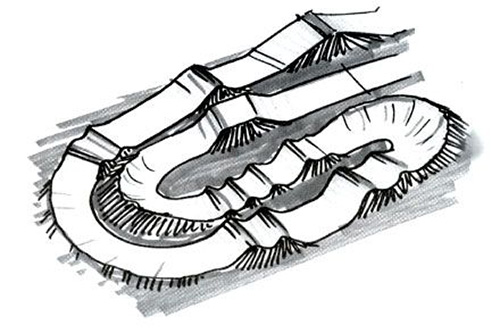
When you get to the top of the starting hill at any BMX track around the nation, you can’t help but feel this huge surge of adrenaline. As you roll your bike in to the starting lane – whether it’s for the first time ever or the thousandth time in years, you know you’re about to experience the thrill of a lifetime. A thrill that no other sport can provide. As you scope out the track one last time before setting up to start, you feel that rush. Soon as the starting gate slams down, the next 30 to 40 seconds is like a wild dirt roller coaster that you are in complete control of.
From the two-year old learning to balance on the Strider pushbike, to the expert athlete flying over the obstacles with the greatest of ease, to the seasoned rider who still digs the rush of the ride, every track has something fun for every level of rider. And that’s the really great thing about going to the BMX track; big or small, novice or expert, you ride at your own speed.
While in football, basketball, baseball or soccer – every field of play will always be identical. Not so in this action sport. While every course has a starting gate and a finish line, that’s where the similarity begins and ends. No two tracks are identical. The lengths of tracks will vary as much as the size and arrangement of obstacles. Some are fairly flat while other have faster downhilll sections. Some shorter tracks will be 900 feet long while others can be as long as 1,300 feet. Today’s USA BMX tracks are nothing like the rough and rocky tracks your dad or grandfather rode “back in the day”. Today’s BMX tracks are a thoughtfully designed and meticulously groomed race course.

Aka the “back of the hill”. Where racers line up in their “moto” waiting for their shot at a little BMX glory.
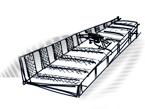
24 feet and 8 lanes wide. Racers start from their assigned gate ready and watching for the light to go!

Some are big. Some are really big. And some, like the Olympic hill, is scary big! All give you the speed to get going in a hurry!

Everything between the turns. They’d be a straight line to the winner’s circle if it weren’t for all those obstacles along the way!

There are big 180s, quick 90s and long, long sweepers. Taking the fastest line around can move you from almost last to fast out in front!

The classic BMX jump. Two hills spaced just enough apart to make the air the fastest line to success if you can.

A short hill followed immediately by a taller hill. Jump up to jump out front!

A tall hill followed immediately by a smaller hill. Push down to push your speed!

A small hill. But they can come at you one, two, three, four at a time or more.

Like the name says. This combination of jumps isn’t about size but rather all about timing and “flow”.

A flat top jump good for learning to catch air and pose for the crowd!
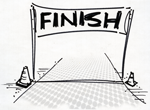
Where the fast times and fun ends. Until you do it again!
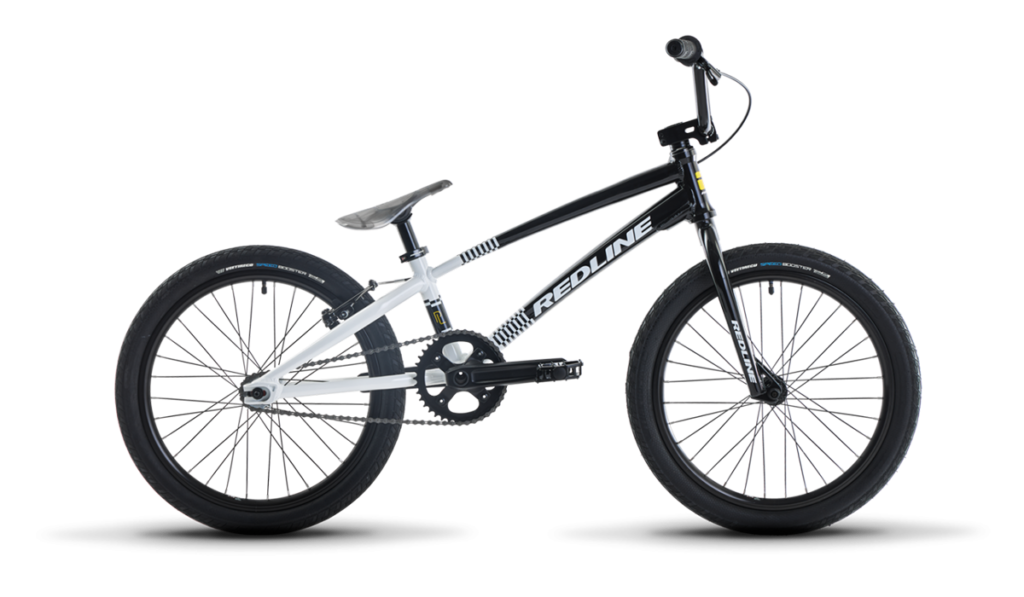
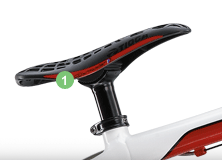
When sprinting and jumping around a BMX course, you'll rarely sit down on your seat--which is why most modern day racers run it as low and out of the way as possible. Since riders usually only sit on their seat in staging or after the finishline, race saddles are made as lightweight as possible, and without very much padding. Comfort is not a priority.
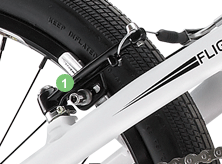
During the 30 to 40 second lap, BMX racers rarely use their brakes. Sure, you'll need 'em to stop at the finish line, or maybe to slow you down to make a pass in a turn, and it is a USA BMX rule that your brakes must work. For this reason, BMXers these days only run a brake in the back; for there is no need to run a front brake.
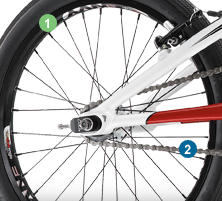
As mentioned earlier, true BMX bikes are single speeds - without any gears, no shifters and definitely no derailuers. Depending on the track or rider preference, you'll most often find a 15 or 16 tooth cog on the rear. The most common type of rear BMX hub is a freewheel (with a thread-on freewheel) or a cassette (where the cog slides on). While some first-time or beginner riders begin with a coaster (back-pedal activated) brake, you'll do much better in racing with a freewheel or cassette.
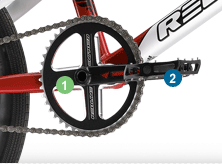
Crank length can vary from 140mm (for the small tykes) to 180mm for the largest riders, and are usually made of either alloy or chromoly. Gearing in BMX racing is single-speed, and the front sprocket will range from 41 to 44 teeth. First-time racers should always start off with platform pedals, and as a riders' skills improve (like when they've turned Intermediate or Expert), they may eventually prefer to switch to clipless pedals.
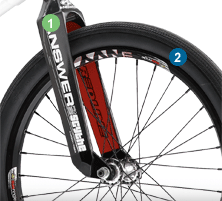
The front fork of any BMX race bike needs to be strong, as it takes the blunt of the impact if you come up short on a jump. While most forks are made of steel, there are also alloy or carbon-fiber versions, as well.
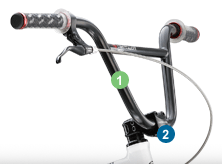
Hold on tight - this is BMX Racing! From the grips to the bars, stem to headset, the height, width and length will vary depending on your size. While the younger riders prefer alloy or carbon-fiber handlebars, most larger riders will only rely on chromoly bars for strength and stiffness.
FACT: BMX racing isn’t any more dangerous than other youth sports. Statistics have shown that kids in the traditional (less “extreme”) sports such as basketball, football, baseball and soccer suffer more injuries than in BMX racing. The reason why, perhaps, is that USA BMX requires protective gear. You can’t go on the track without it. While the level or amount of safety gear is up to you, a rider must at least sport the basics of an approved helmet, long sleeve shirt and long pants.
Below, we introduce you to all of the safety gear that is available for you to protect every area of your body.
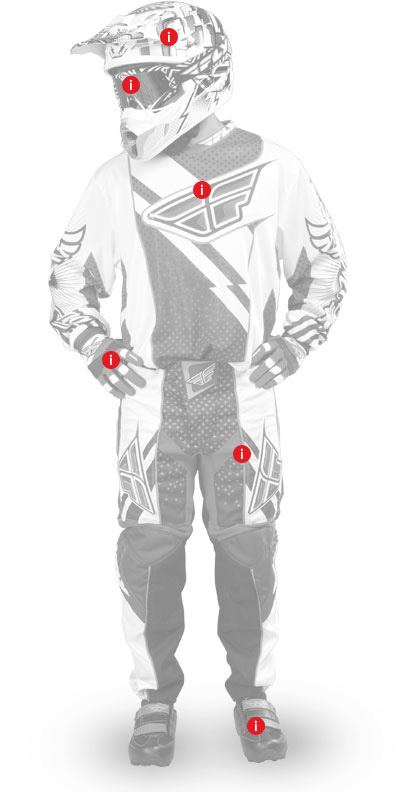
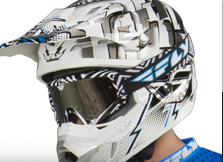
This is obviously the most vital part of safety equipment in BMX, as it protects the most important part of your body - your brain. And don't forget your teeth - which is why USA BMX tracks all recommend a full-face style helmet. While you should have a helmet that passes CPSC standards, a motorcycle-approved DOT helmet is never a bad idea. We've heard it said that you should only buy a $40 helmet if you've got a $40 brain. This is one area in safety gear where skimping on price should not come to play.
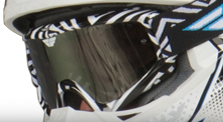
Eye protection - whether its sunglasses or goggles, or nothing at all, is completely up to the rider. The current "factory" trends in BMX racing though, is to sport the coolest goggles with mirrored lenses. They not only keep any wind out of your eyes, but they also come in handy for psyching out the competition.
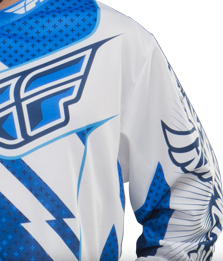
Race jerseys are available from all of the major bike brands and safety-gear companies. When shopping for a jersey, it's just as important to choose the right color and graphics, as it is for picking one with ample padding and a good fit. USA BMX rules state that you may wear a short sleeve shirt - but only when accompanied with full elbow padding.
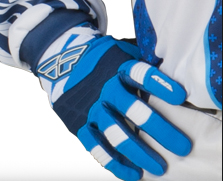
Hand protection is not required to race at a USA BMX track, but they definitely are recommended by anyone who's bailed one or two times in an asphalt turn. Race gloves come in all styles and materials, so be sure to try on plenty and pick the one that you feel fits you best. Modern-day gloves are a lot thinner than the usual bulky, MX-style gloves that were once popular in the 70's and 80's.
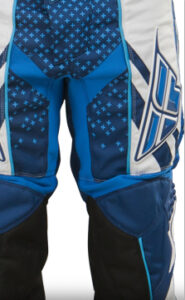
Race-specific pants will provide you more protection and padding for your knees, hips and shins. USA BMX rules do allow riders to wear shorts, but only when paired up with approved full knee/shin guards. For your first BMX race ever, a pair of long jeans will do just fine.
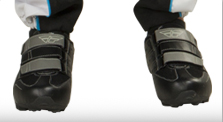
Any tennis shoe will do for racing BMX, but the flatter the sole (such as skate shoes), the better for gription on a platform pedal. As you move up in classification (Intermediate or Expert), you may eventually decide to try clipless pedals; which require a special spring-loaded pedal and cleated-shoe that clip your feet to the pedals. Going clipless is only recommended for older riders and experts.

Signup for our enewsletter for updates on our club, practices and race events!